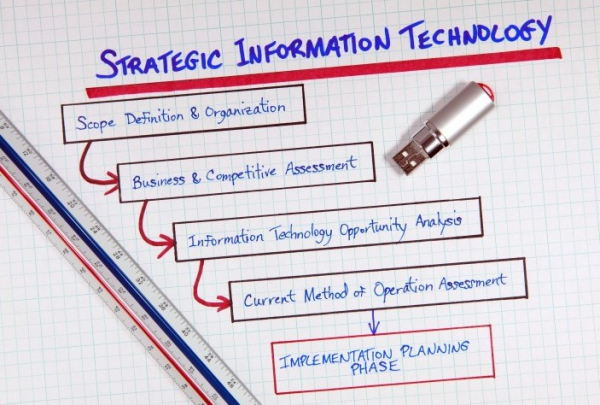
 Data Structure
Data Structure Networking
Networking RDBMS
RDBMS Operating System
Operating System Java
Java MS Excel
MS Excel iOS
iOS HTML
HTML CSS
CSS Android
Android Python
Python C Programming
C Programming C++
C++ C#
C# MongoDB
MongoDB MySQL
MySQL Javascript
Javascript PHP
PHP
- Selected Reading
- UPSC IAS Exams Notes
- Developer's Best Practices
- Questions and Answers
- Effective Resume Writing
- HR Interview Questions
- Computer Glossary
- Who is Who
Role of IT Professional as a Strategic Resource
Many industry experts opine that the mark of any business is to keep itself abreast with information technology breakthroughs. It is the age of technology, which can seldom be relevant when your business is no longer integrated with IT and vice versa. Business and IT strategies have become more relevant than ever before and hence, all the evaluation frameworks that verify fundamental rethinking and redesigning of critical and contemporary industry best practices should be properly aligned. The role of IT as a strategic resource calls for technology-centric overhauling of the established and accepted organizational processes. In essence, even the great business models fail to deliver extraordinary results without IT professionals.

IT as a Viable Avenue to Foster Strategic Vision
Let me explain with an example how IT can foster strategic vision. Walmart, the reputed American multinational retailing giant wanted to do away with all unnecessary distribution steps. It is a known fact that ‘distribution’ comes under the gamut of Supply Chain Management. Redundant steps in Supply Chain management will result in unnecessary costs. In its endeavors to minimize both distribution costs and distribution steps, Walmart came-up with a strategy where suppliers were linked to various retail stores.
- When this strategy was discussed with IT professionals, IT department came up with an enterprise-wide software that connected all retail locations, distribution warehouses and other major supplies. The whole Supply Chain system was thus redesigned.
IT – For Identifying Customer’s Objectives
IT helps you in tracking sales information. In addition, it helps you break both geographic and organizational barriers. Amazon recently released a product called Amazon Dash, a Wi-Fi connected device that allows its users to order a list of items thereby enabling seamless grocery shopping. If you visit the official website for the smart features of Amazon Dash, there is an un-missable feature called “Never forget an item again.” Customers can give their feedback.
By the way, on the supposed subject of the importance of soliciting feedback Jeff Bezos, the celebrated CEO of Amazon once remarked, “Always take feedback. It may have a bitter taste but has a better after taste.”
IT – For Measuring Performance
Performance is all about measuring the results in terms of cost and quality. And yes, it is also about measuring the results in terms of two parameters – duration and deadlines. While measuring the performance of a professional and charting the existing structure of a process within an organization, it is imperative to leverage proven technologies such as Computer Aided Systems Engineering (CASE).

CASE tools help you draw detailed process models and make edits to process prototypes. Process modeling is currently undergoing a radical evolution. Xerox, the American multi-national corporation that sells business services has vouched for improved productivity. Several divisions and departments at Xerox have moved from process modeling to a systematic generation of computer program code.
- When the old prototype of Union Carbide’s working plan was replaced with a new one, the results were jaw-dropping. Thanks to IT, more than 20 million US dollars were saved. A colossal number indeed!
IT – Harbinger of Positive Results

According to a survey by PricewaterhouseCoopers (PwC), IT can serve as a harbinger of positive results. Let me explain this with a simple example. When Hewlett-Packard was started in 1939, inventory information was stored in non-electronic form. This continued till the late 70s. However, the company professionals and management personnel soon realized that if the data is in electronic form, employees can view them any time and use the data for collaboration.
Moreover, paper costs can be cut down. Due to the presence of precise figures and in-depth details, sales processes skyrocketed.
Buoyed by the results, HP gave laptops to its sales representatives thereby enabling them to communicate and collaborate with their customers, peers and superiors. Thanks to strategic IT initiative, time spent in personally meeting and travelling decreased by 46%.
IT – To Achieve Strategic Business Objectives
Companies have a perfect recipe for strategically leveraging Information Technology. They have pitched in unison for the so-called Knowledge Management Systems (KMS). Knowledge Management Systems are a repository of PPP – processes, patterns and procedures. They are an assortment of objectives and best practices. The key information sharing, storing and distributing technologies that play a pivotal role in Knowledge Management Systems are data mining techniques, OLAP cubes, Video conferences, Internet web sites and Intranet discussion forums. Once the knowledge management systems are made available to every potential employee of the organization, he/she can acquaint themselves with the business know-how and the required worker training material. This in turn helps in achieving strategic business objectives.
Well, the list is endless and the examples are innumerable. IT helps in taking better decisions and its contribution as a powerful driving force in positively affecting businesses is paramount. IT helps you realize three things – Integrate, Innovate and Improve.
Bottom-line
The very notion that IT professionals can contribute only to hardware and software programming is not a valid notion. It is in the best interest of the organizations to promote IT professionals to top tier key decision making roles. It is undoubtedly IT that can change the not-so pleasant status quo and embrace ‘new thinking’ and ‘be open to change’ mindset. Need I say more? IT professionals are undoubtedly the best strategic business and human resources.
Let us conclude this article with one of the most apt saying from Albert Einstein: “It has become appallingly obvious that our technology has exceeded our humanity.”

